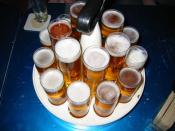Excessive Alcohol Consumption- Its Effects and Social Acceptance Rumors and old wives' tales such as stress makes women heavier drinkers, divorce prompts heavy alcohol use, people drive better when they are drinking, and teenagers are the main group of drunk drivers, are being thrown at today's society left and right in an effort to blame the other guy. With all the talk about alcohol use and abuse these days, people are lost between fact and fiction. All of this tossed in with the truth leads to confusion where most of society is torn between tradition and personal beliefs. Alcohol is a destructive drug that can lead to addiction, arrest, illness, and even death; all of these consequences, however, have not caused much of a dramatic change in alcohol's social acceptance or usage.
Most people know what alcohol is, but not everyone knows its history, where it comes from, or how it is produced.
Alcohol is a word derived from the Arabic al-kohl, which was a term used to describe eyeliner that Middle Eastern women wore. Later, the definition broadened to mean an exotic substance (Monroe 5-6). It was primarily used among ancient people for special ceremonies, magic, and medicine, and "by about 1500 BC, Egyptian doctors included beer or wine in about 15 percent of their medicines"(Monroe 8-9).
Alcoholic beverages are produced through a process called fermentation using plants such as corn, rye, barley, potatoes, and grapes, and are classified by their types and proofs. Some types of alcohol are beer, ale, stout, porter, malt liquor, wine, whiskey, bourbon, gin, rum, brandy, and liqueur. The term proof refers to the percentage of pure alcohol contained in a drink. While there is no international standard, in the United States, each degree of proof is equal to 0.5 percent alcohol (Fettner 275).


